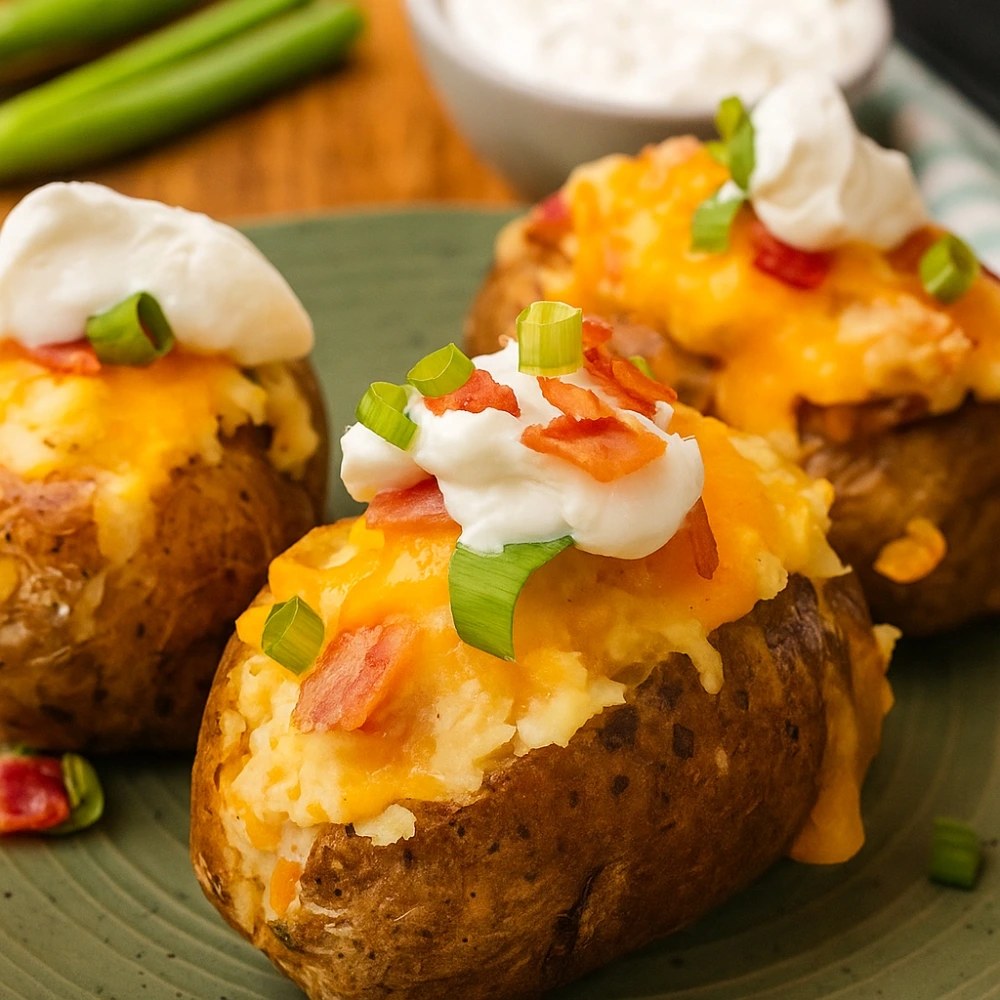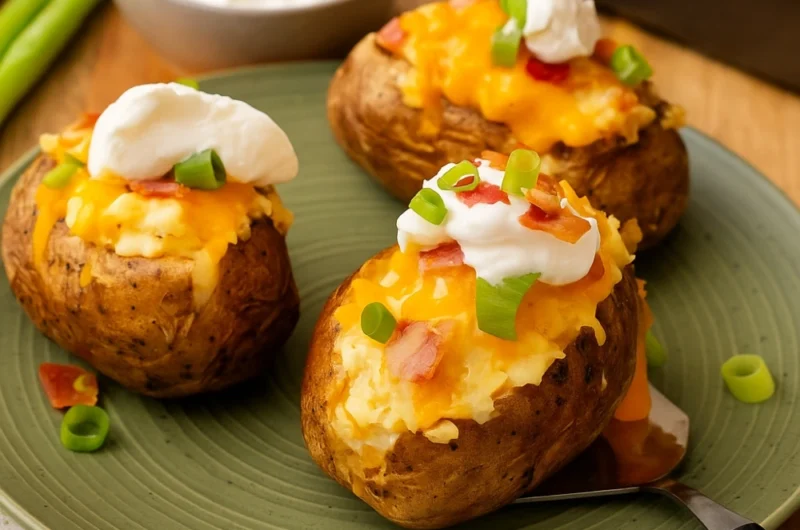The Best Fluffy Pancakes recipe you will fall in love with. Full of tips and tricks to help you make the best pancakes.
Baked Potato

Tired of baked potatoes with soggy skins and dense, sad interiors? You’ve come to the right place. After testing dozens of methods and diving deep into the food science behind perfect baked potatoes, I’m here to share the ultimate guide that will guarantee a perfectly crispy skin and a light, fluffy interior every single time.
Whether you’re looking for the classic oven method, exploring air fryer alternatives, or seeking creative topping combinations, this comprehensive guide covers everything you need to master the art of baked potato perfection. You’ll learn the scientific principles that make the difference, step-by-step techniques for various cooking methods, troubleshooting tips from our test kitchen, and answers to the most frequently asked questions about baked potatoes.
The Two Secrets: High Starch & Dry Heat
The secret to achieving baked potato perfection lies in understanding two fundamental principles that separate amateur attempts from restaurant-quality results.
Why Russet Potatoes Reign Supreme
Not all potatoes are created equal for baking. Russet potatoes contain the highest starch content (around 18-22%) and the lowest moisture levels among common potato varieties. This unique composition is what creates that coveted light, fluffy texture when baked properly. The high starch content breaks down during cooking, creating air pockets that give you that perfect, cloud-like interior.
In contrast, waxy potatoes like red potatoes or fingerlings have lower starch content and higher moisture, making them excellent for boiling or roasting but terrible for traditional baked potatoes. They’ll give you a dense, gummy texture that’s nothing like the fluffy perfection you’re after.
The Foil Trap: Why Wrapping Ruins Everything
Here’s where many home cooks go wrong: wrapping baked potatoes in aluminum foil. While this might seem like it helps cook the potato evenly, it actually creates a steamed environment that prevents the skin from crisping up. Instead of a baked potato, you essentially get a boiled potato with soggy skin.
The magic happens when hot, dry oven air circulates around the potato, drawing moisture from the skin and creating that satisfying crunch. Foil blocks this process entirely, trapping steam and moisture against the potato skin.
The Non-Negotiable: Poking Holes
Those fork holes aren’t just tradition—they’re essential for two reasons. First, they create escape routes for steam building up inside the potato as it cooks, preventing potential explosions (yes, potatoes can actually burst in the oven). Second, these small punctures allow some moisture to escape during cooking, contributing to a better texture overall.
The Gold Standard: Perfect Oven-Baked Potato Recipe
This master recipe has been tested and refined to deliver consistent, restaurant-quality results every time.
Ingredients (Serves 4)
- 4 large Russet potatoes (8-10 oz each, uniformly sized for even cooking)
- 2 tablespoons high-heat oil (avocado oil or refined olive oil—avoid extra virgin which can smoke)
- 2 tablespoons coarse sea salt or kosher salt (not table salt, which is too fine and doesn’t create the same textural contrast)
Why these specific ingredients matter: High-heat oils won’t break down or create off-flavors at 425°F. Coarse salt creates better texture on the skin and doesn’t dissolve completely during baking, providing delightful pockets of flavor and crunch.
Step-by-Step Instructions
1. Prep: Wash AND Dry Thoroughly Scrub potatoes under cold running water with a brush to remove all dirt and debris. The key step everyone misses: dry them completely with paper towels or a clean kitchen towel. Any moisture left on the skin will create steam during baking, preventing proper crisping.
2. Puncture: The Essential Step Using a fork, pierce each potato 8-12 times all around, going about ¼ inch deep. Don’t be shy—more holes are better than fewer. Focus on the thickest parts of the potato where steam is most likely to build up.
3. Oil & Salt: Create the Flavor Armor Rub each potato with oil until the entire surface is lightly coated. Sprinkle generously with coarse salt, pressing gently so it adheres to the oil. This creates a barrier that helps draw moisture from the skin while adding flavor and texture.
4. Bake: Direct Heat Method Preheat oven to 425°F (220°C). Place potatoes directly on the middle oven rack—no baking sheet needed. This allows maximum air circulation. Place a rimmed baking sheet on the lower rack to catch any drippings.
Bake for 45-60 minutes, depending on size. Larger potatoes (10+ oz) may need up to 75 minutes.
5. The Test: How to Know When It’s Done
- Squeeze test: Using an oven mitt, gently squeeze the potato. It should give slightly and feel soft inside.
- Temperature test: Internal temperature should reach 205-210°F (96-99°C) for optimal fluffiness.
- Visual cue: Skin should look dry and slightly wrinkled.
6. The Finish: Cutting and Fluffing Immediately after removing from oven, cut a deep X into the top of each potato. Using a clean kitchen towel, squeeze the ends toward the center to push the flesh up and out. Fluff with a fork to maximize the light, airy texture.
Which Baked Potato Method is Best for You?
Different cooking methods excel in different situations. Here’s your complete guide to choosing the right technique:
| Method | Time | Skin Quality | Best For | Texture Rating |
|---|---|---|---|---|
| Oven | 45-75 min | Excellent crispy | Traditional results | 5/5 |
| Air Fryer | 35-45 min | Very good crispy | Speed + crispiness | 4/5 |
| Microwave | 8-12 min | Poor (soft) | Ultimate speed | 2/5 |
| Grill | 45-60 min | Excellent + smoky | Outdoor cooking | 5/5 |
| Instant Pot | 12-15 min | Poor (steamed) | Meal prep/soft texture | 3/5 |
The Air Fryer Baked Potato (Fast & Crispy)
Perfect for when you want crispy-skinned results in less time. Poke holes, oil and salt as above, then cook at 400°F for 35-45 minutes, flipping once halfway through. The circulating hot air creates excellent skin texture while cutting cooking time by about 25%.
The Microwave Baked Potato (The Speed Demon)
When speed trumps everything else. Pierce potato thoroughly, microwave on high for 5 minutes, flip, then continue for 3-7 more minutes depending on size. The skin won’t crisp, but you’ll have a hot, fluffy potato in under 10 minutes. For slightly better skin, finish under the broiler for 2-3 minutes.
The Grilled Baked Potato (Smoky & Superb)
Adds incredible smoky flavor that elevates any topping. Prepare as for oven method, then cook on medium-high indirect heat (around 425°F) for 45-60 minutes. The slight char and smoke penetration create a uniquely delicious result that’s perfect for outdoor entertaining.
The Instant Pot Baked Potato (Soft & Steamed)
This method creates an entirely different texture—more like a steamed potato. Add 1 cup water to Instant Pot, place potatoes on trivet, and pressure cook high for 12 minutes with quick release. Great for meal prep or when you prefer a softer, less crispy result.
Beyond Butter: The Ultimate Baked Potato Toppings Bar
Transform your perfect baked potato into a complete meal with these inspired topping combinations:
The Classic Loaded
The gold standard that never goes out of style:
- Base: 2 tablespoons sour cream
- Protein: crumbled
- Cheese: ¼ cup sharp cheddar, grated
- Finish: Fresh chives, finely chopped
Pro tip: Add the cheese while the potato is still steaming hot so it melts beautifully into the fluffy flesh.
The Tex-Mex Fiesta
Bold flavors that turn your potato into a southwestern feast:
- Base: 3 tablespoons hearty chili (homemade or quality canned)
- Cheese: Pepper jack or Mexican cheese blend
- Heat: Pickled jalapeños to taste
- Fresh: Cilantro and lime wedge
- Creamy: Dollop of Mexican crema or sour cream
The Mediterranean Dream
Transport your taste buds to the Greek islands:
- Base: 2 tablespoons tzatziki (store-bought or homemade)
- Cheese: Crumbled feta cheese
- Vegetables: Diced tomatoes, sliced Kalamata olives
- Finish: Fresh oregano or dried, sun-dried tomatoes
The Hearty Vegan
Plant-based perfection that doesn’t compromise on satisfaction:
- Protein: ½ cup seasoned black beans, warmed
- Vegetables: Fresh corn salsa with red peppers
- Creamy: Sliced avocado or dairy-free sour cream
- Crunch: Toasted pepitas (pumpkin seeds)
- Fresh: Cilantro and lime juice

Pro Tips from Our Test Kitchen
After hundreds of baked potatoes, here are the insider secrets that make all the difference:
• Uniform sizing matters: Choose potatoes of similar size for even cooking. Weight differences of more than 2 ounces will result in uneven doneness.
• Make-ahead strategy: Baked potatoes can be fully cooked, cooled, and refrigerated for up to 3 days. Reheat in a 350°F oven for 15-20 minutes to restore crispiness.
• Reheating method matters: Never microwave leftover baked potatoes—it makes them gummy. Always use the oven or air fryer to maintain texture.
• Leftover magic: Day-old baked potato flesh makes incredible twice-baked potatoes, potato salad, or can be cubed and pan-fried for crispy breakfast potatoes.
• Size selection: Choose potatoes between 8-12 ounces for optimal results. Smaller potatoes cook too quickly and can become dry; larger ones may not cook evenly.
• Storage wisdom: Store raw potatoes in a cool, dark place (not the refrigerator, which converts starches to sugars). Use within 2 weeks for best results.
Frequently Asked Questions about Baked Potatoes
What is the best potato for baking?
Russet potatoes are unquestionably the best choice for baking. Their high starch content (18-22%) and low moisture create the ideal fluffy, light texture. Popular varieties include Russet Burbank and Russet Norkotah. Avoid waxy potatoes like red potatoes, fingerlings, or Yukon Gold for traditional baked potatoes.
What is the perfect internal temperature for a baked potato?
A properly baked potato should reach an internal temperature of 205-210°F (96-99°C). This higher temperature (compared to other cooked foods) is necessary because the starch granules need to reach this heat level to fully break down and create the desired fluffy texture.
Should I wrap my baked potato in foil?
Never wrap baked potatoes in foil if you want crispy skin. Foil creates a steamed environment that prevents proper skin crisping and results in soggy, tough skin. The direct hot air circulation is what creates that perfect crispy exterior.
Why did my potato come out hard?
Hard baked potatoes are typically undercooked. This happens when the internal temperature doesn’t reach 205°F or when the potato wasn’t baked long enough. Large potatoes can take up to 75 minutes. Always use both the squeeze test and temperature check to ensure doneness.
Is it better to use oil or butter on the skin?
Oil is superior to butter for baked potato skin. Butter has a lower smoke point and contains water, which can prevent proper crisping. High-heat oils like avocado oil or refined olive oil create better browning and don’t break down at 425°F.
Do I salt the potato before or after baking?
Always salt before baking. The salt draws moisture from the skin during cooking, contributing to crispiness while seasoning the skin itself. Salt applied after baking only seasons the surface without improving texture.
How do I prevent my potato from exploding in the oven?
Always pierce the potato skin 8-12 times with a fork before baking. This creates escape routes for steam that builds up inside during cooking. Skipping this step can result in potato explosions that make a mess of your oven.
Can I bake potatoes at a lower temperature?
While you can bake potatoes at lower temperatures (350-375°F), it takes significantly longer (60-90 minutes) and doesn’t produce as crispy skin. The 425°F temperature strikes the perfect balance between cooking time and skin texture.
How do I store leftover baked potatoes?
Cool completely before refrigerating in an airtight container for up to 4 days. Never store at room temperature for more than 2 hours. For best quality, consume within 3 days. Freeze for up to 3 months, though texture will be slightly compromised.
What’s the best way to reheat a baked potato?
Reheat in a 350°F oven for 15-20 minutes to restore skin crispiness. Air fryers work excellently at 350°F for 8-10 minutes. Avoid microwaving, which creates gummy texture and soggy skin.
Master the perfect baked potato with this comprehensive guide, and you’ll never settle for disappointing results again. The combination of proper technique, quality ingredients, and understanding the science behind the process ensures bakery-quality potatoes every single time.
Baked Potato
Course: Dinner, LunchCuisine: American4
servings10
minutes50
minutes180
kcalIngredients
4 medium russet potatoes (about 8–10 oz / 225–285 g each)
1–2 tbsp olive oil
1 tsp kosher salt (plus more to taste)
Optional: freshly ground black pepper
Optional toppings: butter, sour cream, chopped chives/green onions, shredded cheddar, bacon bits
Directions
- Preheat oven to 425°F (220°C). Place a rack in the center (baking directly on the rack yields the crispiest skin; use a sheet pan underneath to catch drips if you like).
- Scrub & dry potatoes thoroughly. Prick each potato 6–8 times with a fork to vent steam.
- Oil & season: Rub potatoes with olive oil; sprinkle all over with kosher salt (and pepper if using).
- Bake for 45–60 minutes, depending on size, until skins are crisp and a skewer slides in easily (or internal temp about 205°F / 96°C).
- Finish & serve: Rest 5 minutes. Slit lengthwise, squeeze ends to fluff, season to taste, and add toppings (butter, sour cream, chives, cheese, etc.). Enjoy!

